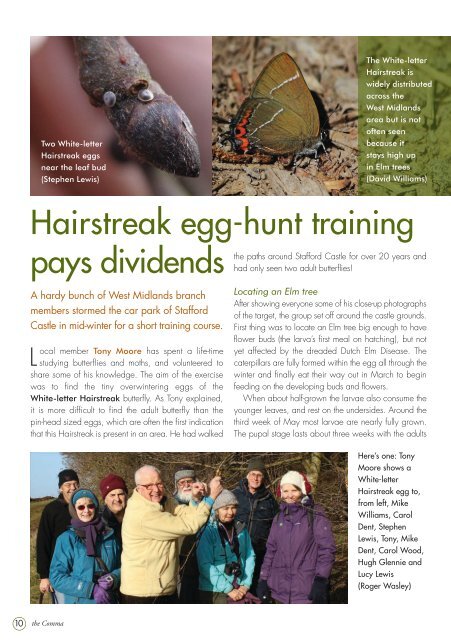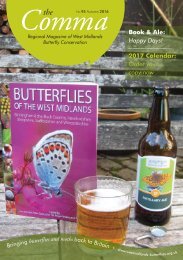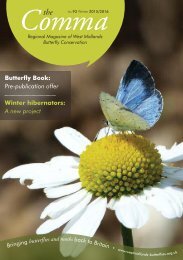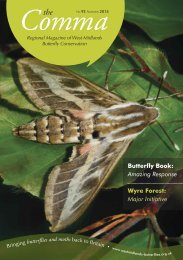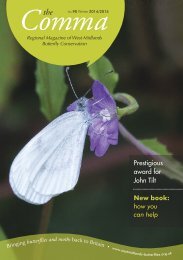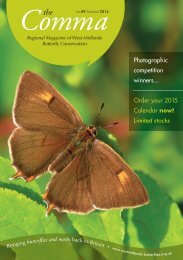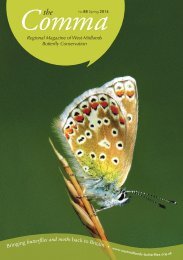Comma No91 Spring 2015
Butterfly Magazine for the West Midlands Branch of butterfly Conservation
Butterfly Magazine for the West Midlands Branch of butterfly Conservation
You also want an ePaper? Increase the reach of your titles
YUMPU automatically turns print PDFs into web optimized ePapers that Google loves.
Two White-letter<br />
Hairstreak eggs<br />
near the leaf bud<br />
(Stephen Lewis)<br />
The White-letter<br />
Hairstreak is<br />
widely distributed<br />
across the<br />
West Midlands<br />
area but is not<br />
often seen<br />
because it<br />
stays high up<br />
in Elm trees<br />
(David Williams)<br />
Hairstreak egg-hunt training<br />
pays dividends<br />
A hardy bunch of West Midlands branch<br />
members stormed the car park of Stafford<br />
Castle in mid-winter for a short training course.<br />
L<br />
ocal<br />
member Tony Moore has spent a life-time<br />
studying butterflies and moths, and volunteered to<br />
share some of his knowledge. The aim of the exercise<br />
was to find the tiny overwintering eggs of the<br />
White-letter Hairstreak butterfly. As Tony explained,<br />
it is more difficult to find the adult butterfly than the<br />
pin-head sized eggs, which are often the first indication<br />
that this Hairstreak is present in an area. He had walked<br />
the paths around Stafford Castle for over 20 years and<br />
had only seen two adult butterflies!<br />
Locating an Elm tree<br />
After showing everyone some of his close-up photographs<br />
of the target, the group set off around the castle grounds.<br />
First thing was to locate an Elm tree big enough to have<br />
flower buds (the larva’s first meal on hatching), but not<br />
yet affected by the dreaded Dutch Elm Disease. The<br />
caterpillars are fully formed within the egg all through the<br />
winter and finally eat their way out in March to begin<br />
feeding on the developing buds and flowers.<br />
When about half-grown the larvae also consume the<br />
younger leaves, and rest on the undersides. Around the<br />
third week of May most larvae are nearly fully grown.<br />
The pupal stage lasts about three weeks with the adults<br />
Here’s one: Tony<br />
Moore shows a<br />
White-letter<br />
Hairstreak egg to,<br />
from left, Mike<br />
Williams, Carol<br />
Dent, Stephen<br />
Lewis, Tony, Mike<br />
Dent, Carol Wood,<br />
Hugh Glennie and<br />
Lucy Lewis<br />
(Roger Wasley)<br />
10<br />
the <strong>Comma</strong>


